William Joseph Scott
25257Royal Engineers
South Africa 1899 - 1902: The Boer War
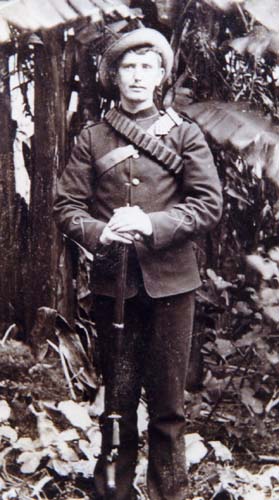
William Joseph Scott served in the Royal Engineers from 7 October 1890 to 26 October 1902. He first went to South Africa in May 1892 and it is likely that this photograph was taken shortly after his arrival there in 1892.
Early Life
William was born on 19 January 1869 in Portsea (Portsmouth), Hampshire, England. He was the last of seven children born to William Scott and his wife Mary (Hyder) Scott. Of these seven only Walter, Elizabeth, Sydney and William Joseph lived to maturity, but Sydney died a young man without issue in 1895(?). By 1883 William Scott senior had taken a position as a principal warder at Parkhurst Prison on the Isle of Wight and it is there that young William grew up. He received an education in at least one school, on the Isle of Wight. By the age of 20 years, 10 months, at the time he enlisted in the Royal Engineers, he claimed to be an engine fitter and it is likely this qualification that allowed his enlistment as a sapper (as privates in the Royal Engineers are called).
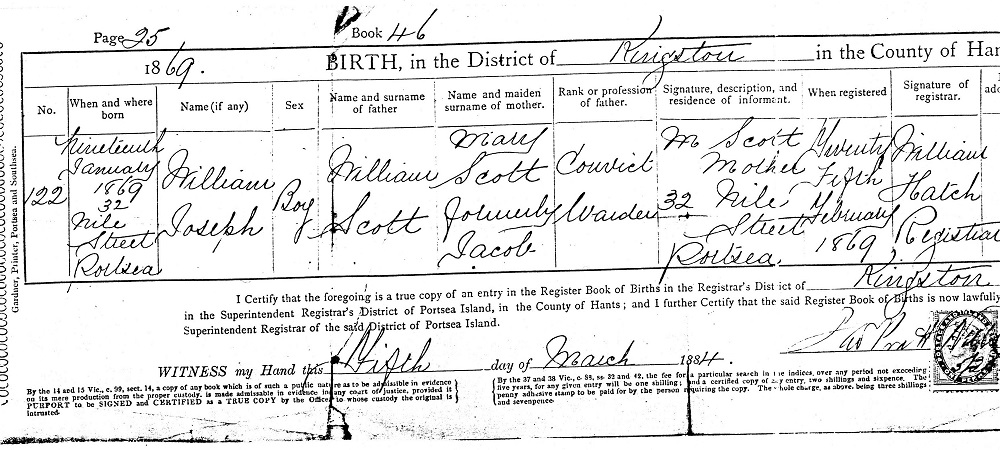
Military Career of William Joseph Scott
Our knowledge of the military career of William comes from a four page service record preserved in the archives in London, England. We show these below in the section on his service record.Attestation
The first two pages of the service record deal with his attestation and enlistment processing. They provide an insight as to his physical stature, his health and his qualifications at the time of enlistment. He was 5 ft. 7 inches, weighed 127 lbs., had a chest size of 34.5 inches, light brown hair and light brown eyes. He was considered medically fit for service. His enlistment was approved and he joined on 7 October 1892 for a 12 year service the first 7 years of which would be on active duty with the remaining 5 to be in the first class of the army reserve, unless he was serving overseas at the end of 7 years in which case regular service would be for 8 years with 4 years in the first class of the army reserve.Service
The service record as given in the final four pages of the document is very brief and recorded in the following table:| Country |
From |
To |
Years |
Days |
| Home |
7-10-90 |
10-5-92 |
1 |
216 |
| South Africa |
11-5-92 |
17-7-98 |
6 |
68 |
| Home |
18-7-98 |
7-11-99 |
1 |
113 |
| South Africa |
8-11-99 |
21-10-01 |
1 |
348 |
| Home |
22-10-01 |
8-4-02 |
169 |
|
| South Africa |
9-4-02 |
10-9-02 |
155 |
|
| Home |
11-9-02 |
26-10-02 |
46 |
This service gave him a total of 12 years and 20 days service. The record does not indicate where he served in these countries ('Home' being England, Scotland and Ireland). We can however gain some greater knowledge as a result of the unit he belonged to, regimental histories and the campaigns for which he received awards. This detail is provided, when possible, below. During his service the records seem to indicate that he was initially released from active service into the active reserves (AR) on 19-7-98 which would have been after almost 8 years service. He was then recalled to active service by the special army order of 9-10-99 as a result of mobilization for the Boer War. The service records indicate that he was released from service in Chatham on 26 October 1902.
Medals and Clasps
The service record shows that William was awarded the King's South Africa Medal with clasps for 1901 and 1902 as well as the Queen's South Africa medal 1899 - 1902 with clasps for Johannesburg, Diamond Hill, Belfast, Cape Colony and the Orange Free State. These awards allow us to gain a little better understanding of where and when he served in South Africa. The following image of these medals is not from those awarded to him, but they do give us an idea of the medals he wore: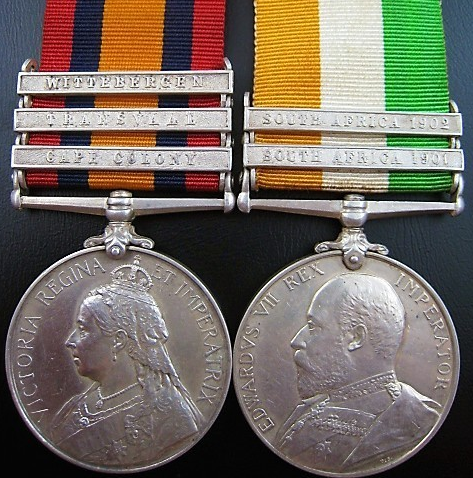
(These are not those issued to William Joseph -- we have not been able to locate them)
The medal on the left is the Queen's South Africa (QSA) medal. The clasps shown in this image differ from those awarded William. He had the lower one "Cape Colony" and above that moving up would have been "Orange Free State", "Johannesburg", "Diamond Hill" and "Belfast". The medal on the right, the King's South Africa medal would have been worn by William as shown here with the 1901 and 1902 clasps.
The initial authorization for the medal was given as follows[1]:
"The QSA and its clasps were authorized in Army Order 94 of April 1901. The preamble set the scope for the medal:
1. His Majesty, the King, has been graciously pleased to confirm the order given by her late Majesty Queen Victoria that a Medal be struck to commemorate the military operations in South Africa.
2. The
Medal in silver, will, provided the claims are approved
by the Commander-in-Chief, be granted to all officers,
warrant officers, non-commissioned officers and men of
the British, Indian, and Colonial Forces, and to all
nurses and nursing sisters who actually served in South
Africa between October 11th, 1899 and a date
to be hereafter fixed; to all troops stationed in Cape
Colony and Natal at the outbreak of hostilities; and to
troops stationed in St Helena between April 14th,
1900, and a date to be hereafter fixed."
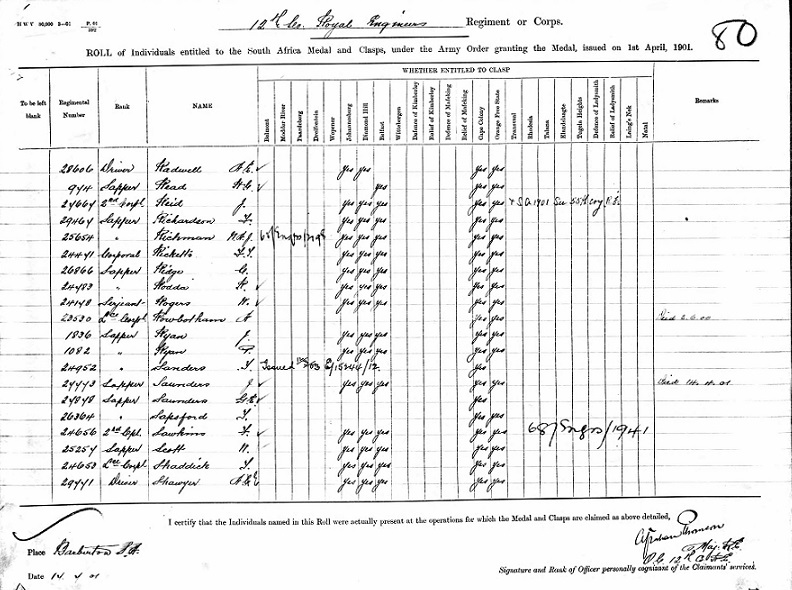
Supplemental Roll of South Africa Medal and Clasps
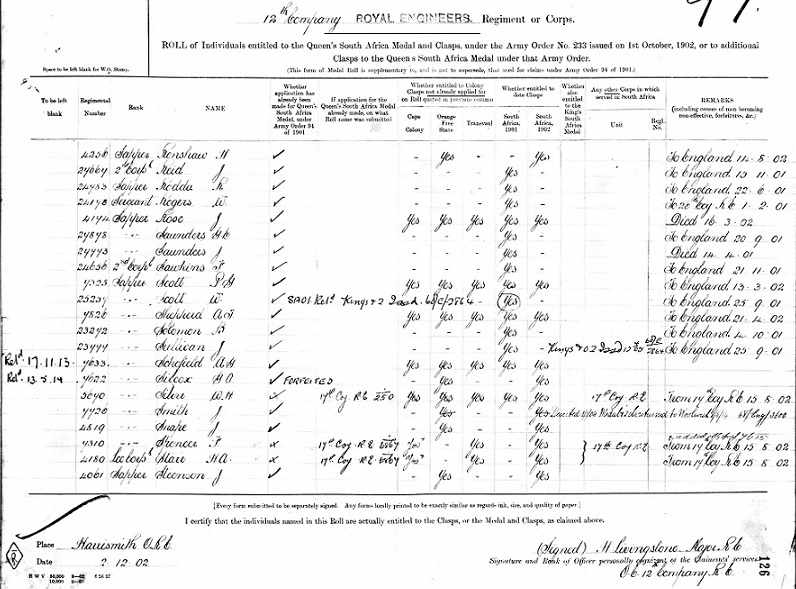
These rolls provide the additional information that William served with the 12th Company of the Royal Engineers. It also indicates that he was a Sapper (a private) rather than, for example, a driver and so he would have been engaged in the engineering aspects of the work of the engineers.
However the second roll is in error and conflicts with his military record sheet (shown below). Although he returned to England in 1901, he was again in South Africa in 1902, and so was eligible for the 1902 clasp in addition to the 1901 clasp for the King's South Africa Medal. The reason for the trip back to England in 1901 is not clear: his record shows that he was not wounded. For some reason there was a delay in the issuing of the King's South Africa Medal to William and this became the cause of subsequent correspondence between William's father and the Royal Engineer's Record Office. We do not have a copy of the initial letter from his father, but the reply is shown below.
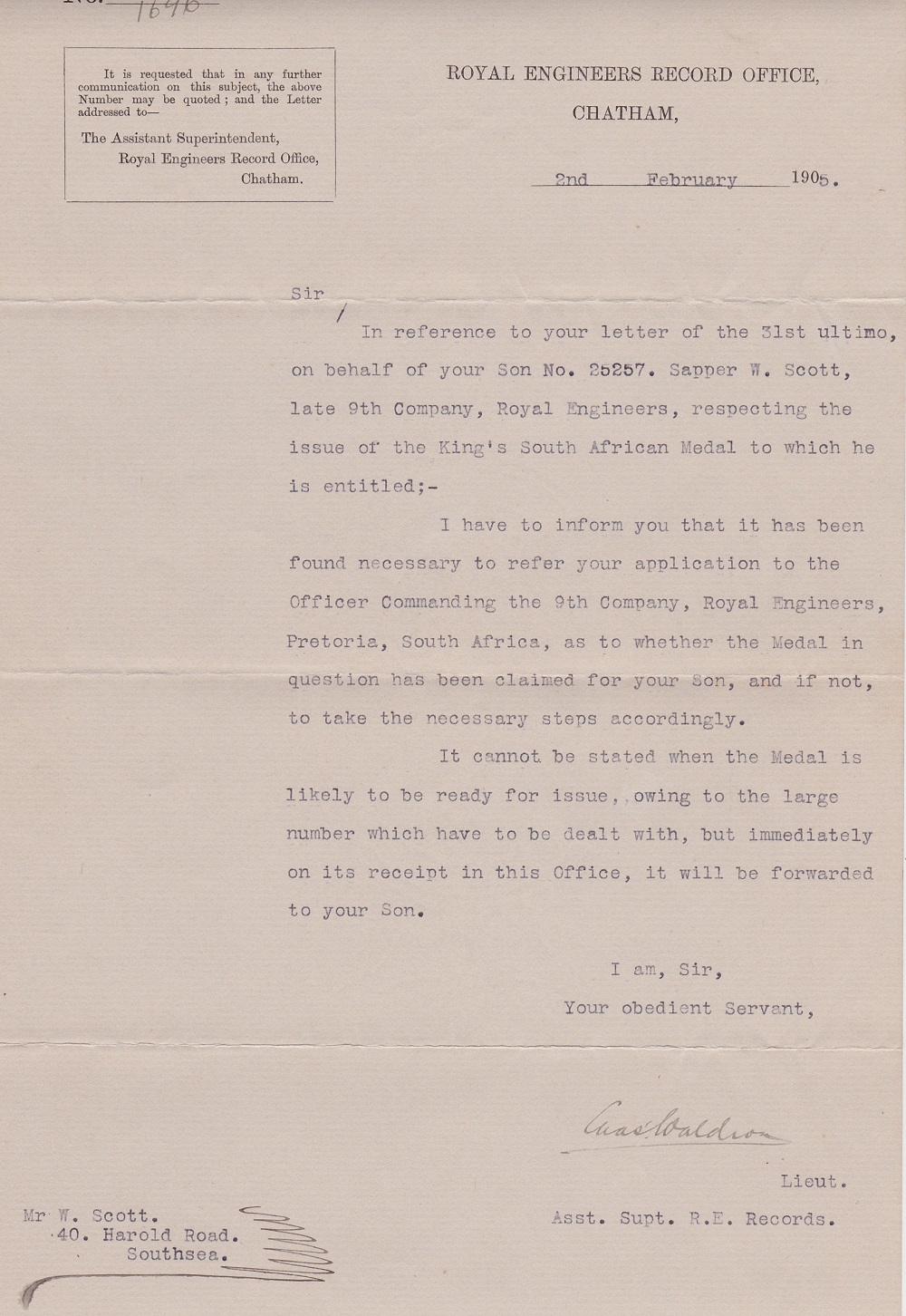
The issue of the missing medal was addressed by the 9th Company records department as we see in the following document.
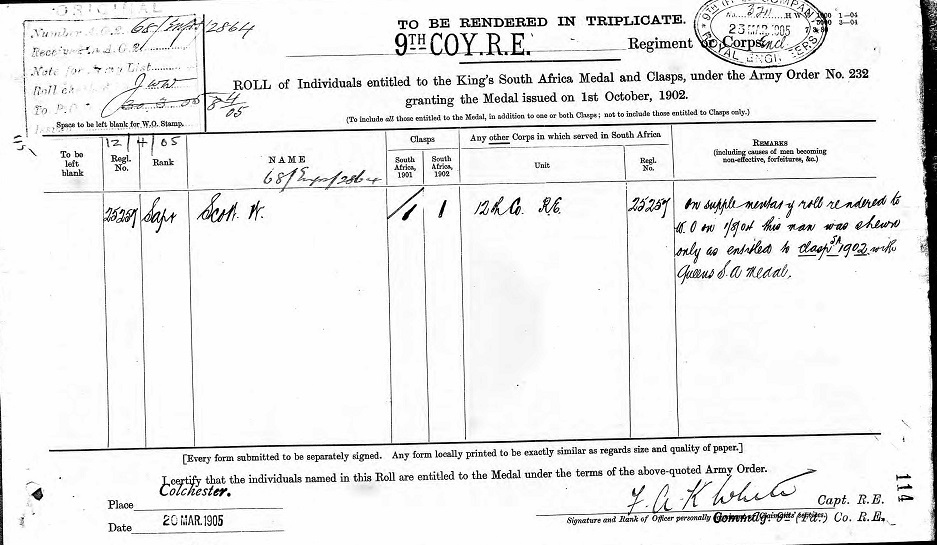
There are a number of other letters and roll entries relating to William's medals and the confusion that his being with two different companies created, he being with the 12th Company for the first posting during the war and with the 9th for the second posting. The last correspondence indicates a full resolution of the matter:
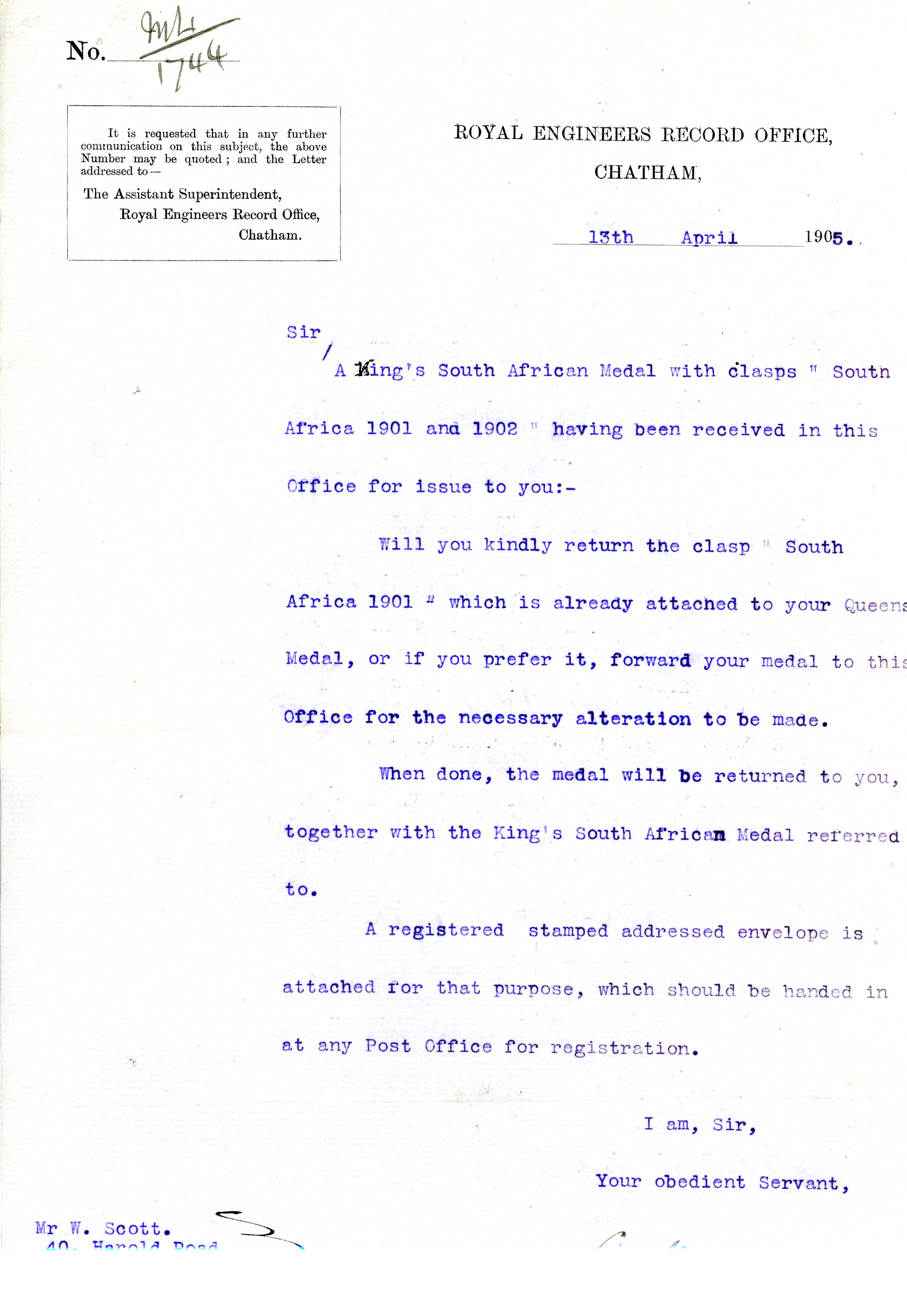
Since we do not know the current disposition of the medals we can only assume (especially knowing his father's character) that the medal was ultimately received and the issue of clasps was sorted out.
Below we list the clasps awarded to William together with some of the details related to such awards.
Cape Colony
"A clasp inscribed "Cape Colony" will be granted to all troops in Cape Colony at any time between October 11th, 1899, and a date to be hereafter fixed, who received no clasp for an action already specified in the Cape Colony nor Natal clasps." We know that William arrived in Capetown on about 22 November 1899. What we do not know yet is how long he might have stayed there.Orange Free State
"A clasp inscribed “Orange Free State” will be granted to all troops in Orange River Colony at any time between February 28th, 1900, and a date to be hereafter fixed, who received no clasp which has been already specified for an action in the Orange River Colony."Johannesburg
'A clasp inscribed "Johannesburg" will be granted to all troops who, on May 29th, 1900, were north of an east and west line through Klip River Station (exclusive), and east of a north and south line through Krugersdorp Station (inclusive).'The conquest/liberation of Johannesburg occurred on 29 May 1900. This award indicates that William was there at that time
Diamond Hill
A clasp inscribed "Diamond Hill" will be granted to all troops who, on June 11th or 12th, 1900, were east of a north and south line drawn through Silverton Siding and north of an east and west line through Vlakfontein.Belfast
A clasp inscribed "Belfast" will be granted to all troops who, on August 26th or 27th 1900, were east of a north and south line drawn through Wonderfontein (the garrison and troops quartered at Wonderfontein on those dates will not receive this clasp) and West of a north and south line through Dalmanutha Station, and north of an east and west line through Dalmanutha Station.
This description was subsequently changed to read: A clasp inscribed "Belfast" will be granted to all troops, who, on August, 26th or 27th, 1900, were east of a north and south line drawn through Wonderfontein (the garrison and troops quartered at Wonderfontein on those dates will not receive this clasp), and west of a north and south line through Dalmanutha Station, and north of an east and west line through Carolina, the word Carolina being substituted for Dalmanutha Station in the original text.
A Brief Military History of the Boer War
Rather than attempt a history of the Boer War, this description attempts to give some context to the activities of William Joseph Scott in South Africa between 1892 and 1902.South Africa (The Cape Colony) had become a British Possession and Colony after the Napoleonic Wars when it became part of the British Empire as a self governed colony. It was important to Britain as it was on the main sea route to India (prior to the opening of the Suez Canal in 1907) and as such provided a haven and restocking point for British maritime trade. The population was essentially of Dutch descent as area had been settled by the Dutch in the 1600s. During the latter 1800s the local population, the Boers, had never been assimilated as a part of the English governship of the area and for various regions portions of this population split off from the colony and marched inland ("The Trek") to create two new state in the interior: The Orange Free State and the Transvaal. The interior states became wealthy through the discovery of the Kimberly diamonds and the gold in Johannesburg, leading to an influx of non-Boers and pressures for other control from such sources as Cecil Rhodes. Mixed in with the economic pressures were issues related to the treatment and rights of the native black and mixed race coloured populations.
These tensions were heightening in the 1890s when William first went to South Africa. They escalated to war in 1899 which led to his recall and return to South Africa in the fall of that year under a general mobilization of forces which led to armed conflict between the Boers of the Transvaal and the Orange Free State in October of that year.
The following map of South Africa in 1899 allows one to see the various locations for which William received clasps. The railroads are clearly indicated. It was generally along the railroad lines that the major military campaigns were waged and it is quite likely that William was involved in the efforts to keep these rail lines open.
The Service Record of William Joseph Scott
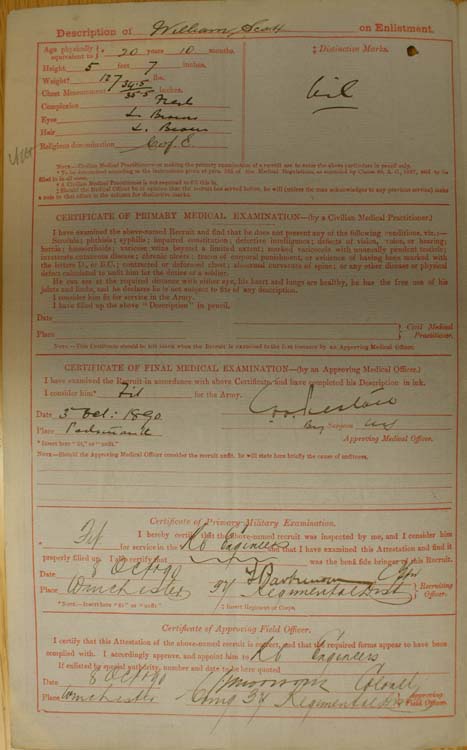 |
|
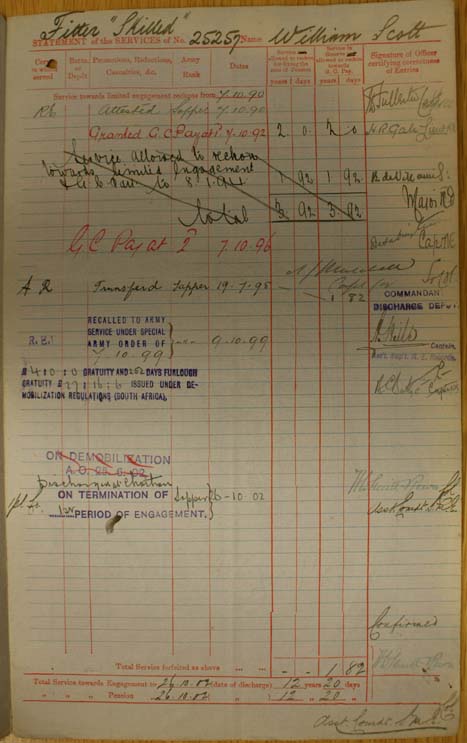 |
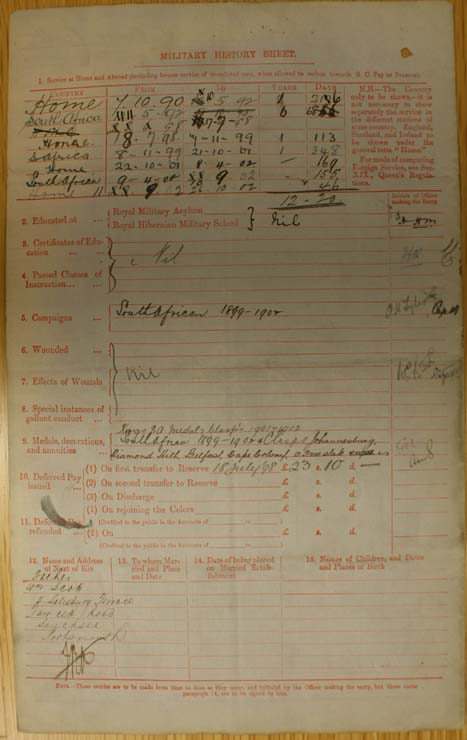 |
The service record provides only a skeleton idea of the experience of William in his military life and in his actions during the Boer War. We do learn that he was in South Africa from 1892 through 1898 prior to his being released to the reserves in England after completing his active service. As such he was an experienced South Africa sapper. Upon the start of hostilities some of the reserves were brought into active service and William was among those called up and sent to South Africa. We do not know what unit or units he was with during his first posting in South Africa. During the war he served first with the 12th Company. Then after a period back in England (most likely in Chatham, Kent) he was again dispatched to South Africa and served with the 9th Company.
The clasps to his medals give some idea of his travels in South Africa during the war. Now that we know of the companies he was attached to we will be able to search for the company war diaries to perhaps find more details on his activities.
William in Later Life
We have little information on William in his later life. In a recording made in the 1950s his niece, Kitty, recalled that she had seen him on the beach in Portsmouth in the early 1900s.Acknowledgments and Sources
The following have helped by providing information used in this presentation- Iris Groutage and her daughter Jennifer for the
photograph of William Joseph Scott in Africa about 1892
and various letters and other information
- David . . . for the service record of William.
- Ancestry.com has copies of the rolls that are shown
above as well as a few other items relating to William.
©Kenneth Scott and others 2010,2011, 2012, 2013, 2014
email: ken at kenscott.comlast revised 26 December 2014